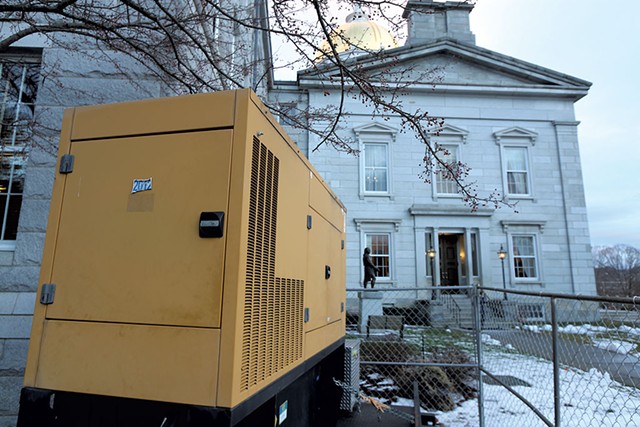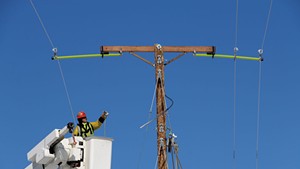
- Kevin Mccallum
- A generator at the Vermont Statehouse
In January 2021, Vermont declared itself the first state in the nation to install a battery backup system in its Statehouse. The new batteries replaced an aging propane generator in the Statehouse basement and stored enough juice to run the building's lights, computers and elevators for up to four hours during an outage.
Gov. Phil Scott hailed the achievement as evidence of "out-of-the-box thinking, common sense and collaboration," saying "Not only is this a cutting-edge solution that reduces both carbon emissions and costs, but it also increases reliability."
Four months later, the state's insurance company offered a different description of the lithium-ion battery packs: fire hazard. If the $400,000 system ever ignited, the resulting blaze would be extremely difficult to extinguish, Continental Casualty warned.
"That's a situation where if you had a fire and it's uncontrolled, it would burn down the entire Statehouse," Jennifer Fitch, the commissioner of Buildings and General Services, told Seven Days.
The walls of the historic gold-domed building are hung with irreplaceable artwork. From January to May, the Statehouse is filled with lawmakers and staff; year-round it is a popular destination for tourists and schoolchildren. All of those factors played a role in the decision to remove the batteries in late 2021.
Plans are now under way to reinstall the batteries — originally placed in the basement to protect them from the weather — in a safer location outside the Statehouse.
The episode underscores the challenges Vermont faces as it tries to transition from fossil fuel energy systems to newer but often less understood alternatives.
"We were being early adapters," said Rep. Curt Taylor (D-Colchester), who served on the House Corrections and Institutions Committee, which signed off on the battery installation.
Lawmakers and building officials apparently failed to heed early warnings about the potential fire danger and opted for the basement location in part to sidestep the cumbersome Statehouse bureaucracy.
Erik Filkorn, an official in the Department of Buildings and General Services, told lawmakers in 2018 that putting the batteries outside would have triggered a review by the Capitol Complex Commission. The five-member body is charged with overseeing the architectural and aesthetic integrity of the historic capitol complex.
Rep. Alice Emmons (D-Springfield), longtime chair of the corrections committee, told colleagues at the time that such a review could set the project back many months and increase costs.
"It seems so much easier to put these racks down in the basement," Filkorn testified.
That's where a 1960s-era backup generator was located, but it was too small and unreliable for the building's modern needs. Between 2015 and 2017, the Statehouse had lost power six times, including once because a squirrel got into an electrical transformer. The generator kept some critical systems running but not others, such as computers.
That prompted the state to hire Randolph-based engineering firm DuBois & King to design several options, including more powerful fossil fuel generators and, at lawmakers' request, battery storage systems. The firm and Buildings and General Services officials eventually concluded that a battery system could do the job.
Lawmakers approved $450,000 for the project in 2018, instructing the buildings department to evaluate the options and notify the chairs of the relevant House and Senate committees "prior to purchase of a generator or a battery backup."
The seemingly simple basement solution, however, ignored a growing body of evidence that such systems can pose a significant fire risk. Overheating lithium-ion cells can trigger a chemical chain reaction known as thermal runaway that may cause a battery array to combust. For more than a decade, there have been reports of laptops, hoverboards, electric cars and even commercial airliners being set on fire by overheated batteries.
Just last year, a shipping container full of batteries ignited at electric-aviation pioneer Beta Technologies' South Burlington headquarters. It took firefighters 30 minutes and "copious amounts of water" to extinguish flames that shot as high as 40 feet.
Capitol Police Chief Matthew Romei warned lawmakers and building officials during a committee meeting in 2018 that it would require foam fire retardant, not just water, to extinguish a fire in a large battery system.
But when the Statehouse battery pack was being designed, there was nothing in the building or fire code preventing it from being installed in a basement, Fitch, the buildings commissioner, said. There still isn't.
The National Fire Protection Association, which publishes fire codes often adopted by public agencies, released standards for battery backup systems in September 2019, just before construction began. The association recommended that systems not be installed belowground due to the potential fire danger.
"I think that the national code was new for everybody," Fitch said.
Emmons, the House committee chair, said last week that she didn't recall any safety concerns being raised at the time the project was approved.
Montpelier Fire Chief Robert Gowans wasn't consulted beforehand — and didn't like what he saw when he finally toured the installation. The batteries were only reachable via a single, long hallway, he said.
"It would have been very difficult and unsafe for firefighters to get to that room," Gowans said. "That was my biggest concern."
Rep. Butch Shaw (R-Pittsford), vice chair of the corrections committee in 2018, was an early skeptic. A certified electrician, Shaw was concerned that the batteries would last just a few hours and was also troubled by the fire risk. He only came around after building officials assured him the project would receive any necessary fire permits. He said he doesn't know if that ever happened.
Shaw said he thinks his committee did its due diligence. "We make decisions and we have to live with them, and sometimes we bump into things that are unforeseen," he said.
One of the advantages of the battery system was that, in addition to lowering fossil fuel emissions, it could be used by Green Mountain Power, the state's largest power utility, to reduce electricity costs. Utilities are increasingly turning to large battery arrays that can be charged when power is cheap and discharged during periods of peak demand. This reduces the need to buy power on the open market when prices are higher. This "peak shaving" can reduce power costs.
The state hired Barre-based electrical contractor Norway & Sons to complete the work. It brought on Northern Reliability of Waterbury to build the 250 kWh battery, which is as powerful as three Teslas.
Installation started in September 2019 but took longer than expected because of pandemic supply chain challenges, Fitch said. Work was wrapped up in June 2020, and the system became operational in the fall.
Within months, the utility reported that the battery successfully kept the Statehouse operational during a winter storm power outage. The batteries worked as designed and powered critical systems such as fire sprinklers and elevators.
The following month, an inspector for Continental Casualty toured the Statehouse and took issue with the battery's location. The firm warned that such systems "present a severe fire hazard to the structure and occupants." The company told Buildings and General Services officials the best solution was to move the batteries, but if they chose to keep them in place, they'd have to make major upgrades to the room and fire suppression equipment.
The batteries were hauled out in November and taken to Northern Reliability's facility in Waterbury, where they are hooked up to the grid and continue to perform their peak-shaving function, Fitch said.
Building officials are now waiting for an enclosure to be delivered so the batteries can be installed in the Statehouse parking lot, likely this summer after the legislative session is complete, Fitch said. Last May the Capitol Complex Committee approved the design for a green box tucked behind a hedge.
The project team worked well to overcome the challenges, Fitch said, and the state does not consider anyone to have dropped the ball or failed to meet their contractual obligations.
Today a rented portable diesel generator parked outside the Statehouse's west wing provides backup power. It sits on a trailer behind a chain-link fence beside the bronze statue of the state's first governor, Thomas Chittenden.
Gov. Scott said on Tuesday that the setback was "unfortunate" but he still views battery storage as an important part of the state's energy future.
"We took that one on the chin, but we'll do better next time," he said.












Comments
Comments are closed.
From 2014-2020, Seven Days allowed readers to comment on all stories posted on our website. While we've appreciated the suggestions and insights, right now Seven Days is prioritizing our core mission — producing high-quality, responsible local journalism — over moderating online debates between readers.
To criticize, correct or praise our reporting, please send us a letter to the editor or send us a tip. We’ll check it out and report the results.
Online comments may return when we have better tech tools for managing them. Thanks for reading.